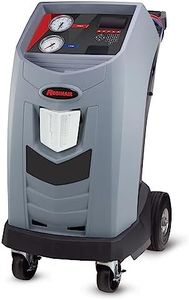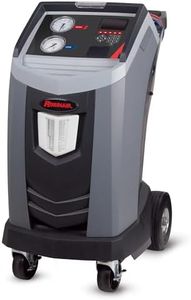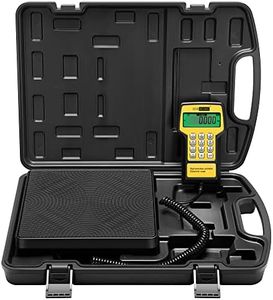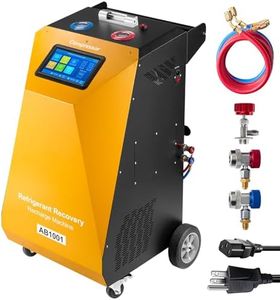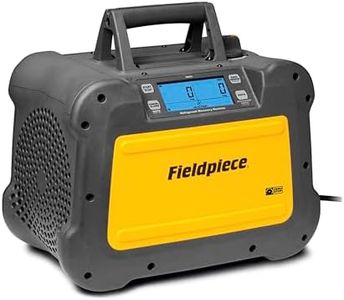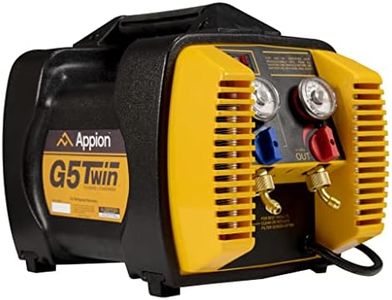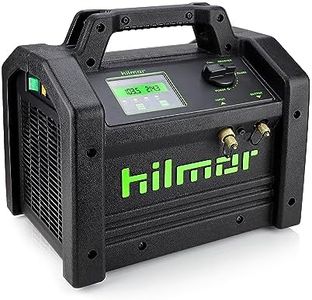10 Best Refrigerant Recovery Tools 2025 in the United States
Our technology thoroughly searches through the online shopping world, reviewing hundreds of sites. We then process and analyze this information, updating in real-time to bring you the latest top-rated products. This way, you always get the best and most current options available.

Our Top Picks
Winner
Robinair 34788NI-H Premier R-134A Refrigerant Recovery, Recycling, and Recharging Machine for Hybrid and Non-Hybrid Automotive A/C Systems
Most important from
87 reviews
The Robinair 34788NI-H is a comprehensive refrigerant recovery, recycling, and recharging machine designed for both hybrid and non-hybrid vehicles, offering a range of automated features. It stands out in terms of ease of use with its fully automated program that manages recovery, vacuum, leak tests, and charging without manual intervention on panel valves. This makes it particularly user-friendly, reducing the likelihood of operational errors. The machine also features automatic air purging and refrigerant refill, which further simplifies maintenance and ensures efficient operation without constant monitoring.
However, at 205 pounds, this model is quite heavy, which may limit its portability. Those who need to frequently move their equipment might find this a drawback. Its compatibility with R-134A refrigerant is suitable for a wide range of applications, but it may not be ideal for users working with newer refrigerants. Safety is enhanced through visual and audible alarms, providing clear notifications on service completion or operational issues.
The build quality appears robust, which contributes to its durability, alongside its solid customer satisfaction rating of 4.1 out of 5 stars. Despite not being the most portable option on the market, the Robinair 34788NI-H's automated features and solid construction make it a strong contender for professional automotive shops focusing on high-volume services where ease of use and reliability are critical. For the more occasional user or those requiring multi-refrigerant compatibility, alternatives might be worth considering. Its dated first availability from 2015 suggests there may be newer models with updated technologies, which could be a consideration for those seeking the latest advancements.
Most important from
87 reviews
Robinair AC1234-4 Premier R-1234yf Recovery, Recycling, and Recharging Machine for Standard and High Voltage A/C Systems
Most important from
13 reviews
The Robinair AC1234-4 is a robust and professional-grade refrigerant recovery, recycling, and recharging machine designed mainly for automotive A/C systems using R-1234yf refrigerant. It stands out with a very high recovery efficiency of 98.5%, which means it quickly and effectively recovers refrigerant, saving time and reducing waste. The machine is fully automatic, with features like automatic oil drain and purge, and internal tank refill, making it user-friendly and minimizing manual intervention. It also includes a built-in refrigerant identifier which ensures you’re only recovering the correct type of refrigerant—important for safety and compliance. Its compatibility with both standard and high voltage systems adds versatility, covering a wide range of vehicle types. Safety is enhanced by programmable vacuum and integrated leak tests to avoid refrigerant loss.
The solid steel build and large size (weighing 206 lbs and measuring 44 x 24 x 44 inches) suggest durability but also mean it’s not very portable; it’s better suited for a fixed workshop than mobile use. The machine is designed to operate within typical shop temperature and humidity ranges but does require standard 115V power. Some optional add-ons allow Wi-Fi and Bluetooth connectivity, which can be useful for tech-savvy users seeking enhanced diagnostics.
Due to its weight and size, the machine could be cumbersome for smaller shops or mobile technicians. This Robinair unit represents a strong choice for professionals needing accurate, efficient recovery and servicing of R-1234yf systems in a stable, workshop environment rather than for light or portable use.
Most important from
13 reviews
Robinair 34288NI Economy R-134a Refrigerant Recovery, Recycling, and Recharging Machine for Standard (Non-Hybrid) Automotive A/C Systems
Most important from
87 reviews
The Robinair 34288NI is designed for recovering, recycling, and recharging refrigerant R-134a in standard (non-hybrid) automotive A/C systems. It offers a solid recovery rate supported by an automatic oil drain feature, which helps users manage oil easily by collecting it in a clear container for simple maintenance. Its automatic air purge adds a safety layer by removing harmful air without needing constant monitoring. The 4.3-inch color display provides useful information in a user-friendly way, including a programmable vacuum function that lets you set the vacuum time up to 99 minutes, which is practical for different jobs.
In terms of portability, the machine is quite heavy at 206 pounds with large dimensions, so it’s better suited for a fixed workshop setup rather than mobile use. Compatibility is focused mainly on R-134a refrigerant commonly used in many vehicles, but it does not support hybrid systems or include an extensive refrigerant database by default, which might limit flexibility for some users.
The noise level is kept under 70 dB, making it fairly quiet compared to other machines in this category. The build quality appears robust and durable, fitting for regular garage or shop use. Although it lacks some advanced features found in pricier models, its automatic functions and clear display make it straightforward for technicians with basic training. This tool is ideal for automotive repair shops or anyone needing reliable refrigerant recovery on conventional vehicles, but it’s less suited for those requiring portability or hybrid system compatibility.
Most important from
87 reviews
Buying Guide for the Best Refrigerant Recovery Tools
Choosing the right refrigerant recovery tool is essential for anyone working with HVAC systems. These tools are used to safely remove refrigerants from cooling systems, ensuring compliance with environmental regulations and preventing the release of harmful substances into the atmosphere. When selecting a refrigerant recovery tool, it's important to consider several key specifications to ensure you get the best fit for your needs. Understanding these specifications will help you make an informed decision and choose a tool that is efficient, reliable, and suitable for the types of systems you work with.FAQ
Most Popular Categories Right Now
